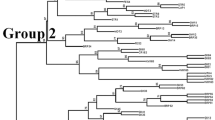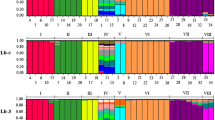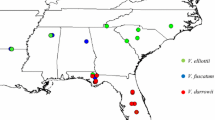Abstract
The objective of this study was to ascertain the usefulness of polymerase chain reaction (PCR)-based microsatellite analysis for studying pollination and parentage in a wind-pollinated temperate tree. A small insert genomic library of the bur oak (Quercus macrocarpa) was constructed and screened for the presence of (CA/GT) n and (GA/CT) n repeats. The proportion of positive clones yielded estimates of 3×105 such dinucleotide repeats per genome, roughly comparable to abundances reported in other eukaryotic genomes. Thirteen positive clones were sequenced. In contrast to mammalian genomes, the (GA/CT) n motif was more abundant than the (CA/GT) n motif in these clones. The (GA/CT) n repeats also showed longer average repeat length (mean n=16.2 versus 7.3), suggesting that they are better candidates for yielding polymorphic genetic markers in oak genomes. Indeed, a survey of adult bur oaks and offspring in a small stand in northern Illinois at 3 of these (GA/CT) n microsatellite loci revealed Mendelian inheritance and extremely high levels of polymorphism, with the number of alleles at each locus ranging from 11–20 and heterozygosity ranging from 0.66 to 0.75. These results, indicating that (GA/CT) n microsatellites are both abundant and highly polymorphic in the bur oak genome, suggest that such genetic markers have tremendous potential for applications for studies of parentage, pollination and dispersal in temperate trees.
Similar content being viewed by others
References
Akkaya MS, Bhagwat AA, Cregan PB (1992) Length polymorphisms of simple sequence repeat DNA in soybean. Genetics 132:1131–1139
Brunel D (1994) A microsatellite marker in Helianthus annuus L. Plant Mol Biol 24:397–400
Chakraborty R, Meagher TR, Smouse PE (1988) Parentage analysis with genetic markers in natural populations. I. The expected proportion of offspring with unambiguous paternity. Genetics 118:527–536
Condit R, Hubbell SP (1991) Abundance and DNA sequence of two-base repeat regions in tropical tree genomes. Genome 34:314–331
Feeny P (1970) Seasonal changes in oak leaf tannins and nutrients as a cause of spring feeding by winter moth caterpillars. Ecology 51:565–581
Greenwood MS (1986) Gene exchange in loblolly pine: The relation between pollination mechanism, female receptivity and pollen availability. Am J Bot 73:1443–1451
Handel SN (1983) Pollination ecology, population structure and gene flow. In: Real L (ed) Pollination biology. Academic Press, New York, pp 163–211
Keim P, Paige KN, Whitham TG, Lark KG (1989) Genetic analysis of an interspecific hybrid swarm of populus: occurrence of unidirectional introgression. Genetics 123:557–565
Lagercrantz U, Ellegren H, Andersson L (1993) The abundance of various polymorphic microsatellite motifs differs between plants and vertebrates. Nucleic Acids Res 21:1111–1115
Levin DA, Kerster HW (1969) The dependence of bee-mediated pollen and gene dispersal upon plant diversity. Evolution 23:560–571
Linhart YB, Busby WH, Beach JH, Feinsinger P (1987) Forager behavior, pollen dispersal and inbreeding in two species of hummingbird-pollinated plants. Evolution 41:679–682
Meagher TR, Thompson E (1987) Analysis of parentage for naturally established seedlings of Chamaelirium luteum (Liliaceae). Ecology 68:803–812
Mitton JB, Linhart YB, Sturgeon KB, Hamrick JL (1979) Allozyme polymorphisms detected in mature needle tissues of ponderosa pine. J Hered 70:86–89
Morgante M, Olivieri AM (1993) PCR-amplified microsatellites as markers in plant genetics. Plant J 3:175–182
Mosquin T (1971) Competition for pollinators as a stimulus for the evolution of flowering time. Oikos 22:398–402
Rassmann K, Schlötterer C, Tautz D (1991) Isolation of simple-sequence loci for use in polymerase chain reaction-based DNA fingerprinting. Electrophoresis 12:113–118
Smillie RM, Scott NS (1969) Organelle biosynthesis: The chloroplast. In: Hahn FE (ed) Progress in molecular and subcellular biology, vol. 1. Springer Berlin Heidelberg New York, pp 136–202
Tautz D, Trick M, Dover GA (1986) Cryptic simplicity in DNA is a major source of genetic variation. Nature 322:652–656
USDA Forest Service (1974) Seeds of woody plants in the United States. U.S. Department of Agriculture, Agricultural Handbook No. 450
Wang Z, Weber JL, Zhong G, Tanksley SD (1994) Survey of plant short tandem repeats. Theor Appl Genet 88:1–6
Weber JL (1990) Informativeness of human (dC-dA) n -(dG-dT) n polymorphisms. Genomics 7:524–530
Weber JL, May PE (1989) Abundant class of human DNA polymorphisms which can be typed using the polymerase chain reaction. Am J Hum Genet 44:388–396
Wolf PG, Soltis DE, Soltis PS (1990) Chloroplast DNA and allozymic variation in diploid and autotetraploid Heuchera grossulariifolia (Saxifragaceae). Am J Bot 77:232–244
Author information
Authors and Affiliations
Additional information
Communicated by P. M. A. Tigerstedt
Rights and permissions
About this article
Cite this article
Dow, B.D., Ashley, M.V. & Howe, H.F. Characterization of highly variable (GA/CT) n microsatellites in the bur oak, Quercus macrocarpa . Theoret. Appl. Genetics 91, 137–141 (1995). https://doi.org/10.1007/BF00220870
Received:
Accepted:
Issue Date:
DOI: https://doi.org/10.1007/BF00220870




